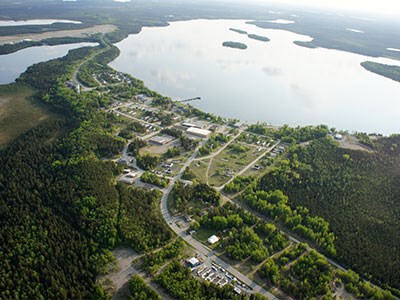Mine development in the Ring of Fire could make or break Pickle Lake.
When Queen’s Park finally decides on how best to spend its $1 billion of infrastructure money to open up the Far North, Mayor Roy Hoffman hopes his community of 400 will still be in the picture to reap some of the spinoff benefits.
It’s for pure self-preservation purposes that Hoffman favours more than one route to reach the mineral riches of the James Bay lowlands rather than just one single, newly created transportation corridor.
“If they create a whole new route to the Ring of Fire and to access the Far North, that cuts us out.”
Located 530 kilometres north of Thunder Bay, Pickle Lake’s entire economy depends on the movement of goods to as many as 20 remote First Nation communities, including the four closest to the Ring.
Hoffman supports the east-west road proposal by Noront Resources, one of the area’s prominent junior mining companies, which follows the winter road supply route now in existence.
“The best thing that could have happened to us is what happened with Cliffs (Natural Resources),” said Hoffman, alluding to the Ohio miner’s decision late last year to indefinitely mothball its Black Thor chromite project.
Cliffs favoured a north-south access route and Hoffman knows the company’s once-heralded plans for a $2-billion chromite mine and refinery project held much sway with the decision-makers at the Ministry of Northern Development and Mines.
But it would have crushed Pickle Lake’s economy.
Situated where Ontario’s paved highway system ends at the northern terminus of Highway 599, Pickle Lake began in the late 1920s as a gold mining town.
After producing more than a million ounces, the Pickle Crow Gold Mine was closed in 1966. It almost permanently shuttered the town which once blossomed to 1,000 people.
But the community kept itself alive as a supply base at the start of the regional winter road network where groceries, fuel and building materials are trucked and flown in to the remote communities.
Aside from the supply chain economy and some scattered nearby gold exploration, there’s really not much else brewing by way of industry, said Hoffman.
Pickle Lake is too far north for tourists to travel by car, and a second phase of cottage lot development didn’t go off as planned because of onerous provincial tax assessments on lakeside properties.
If a permanent north-south route were to connect those communities closest to the Ring, Hoffman suspects more would likely follow. And that would kill or relocate many local small businesses and deal a serious blow to a municipality struggling to stay solvent.
“I realize the Ring of Fire has this huge potential compared to our (town’s) economy, but it’s all we’ve got,” said Hoffman “To go strictly north-south, that pulls the rug out from under our community, and we’ll have to declare bankruptcy. We’re barely making ends meet as it is.”
Noront’s road proposal calls for a 231-kilometre long corridor, passing through Pickle Lake, that would connect its Eagle’s Nest nickel deposit to a proposed transload facility at the CN line at Savant Lake.
Hoffman said an east-west road with a high-voltage transmission line is an historic and natural path of least resistance that follows the flow of rivers and lakes.
A north-south corridor would cross over major river systems like the Albany.
Hoffman hopes the next provincial government takes that into account before it jumps into bed with any one mining company, much as the McGuinty-Wynne government did with Cliffs.
“I was really disappointed when they jumped on board with them right off the bat. Since then, I think they’re taking that sober second thought.”
What development path Queen’s Park will eventually choose – and is willing to fund – is anybody’s guess since the nuts and bolts of establishing a mining district has been contracted out to Deloitte Canada.
“If the north-south route is the only one chosen, there is zero benefit to anyone west of Thunder Bay,” said Hoffman.
Having multiple routes would not only benefit his community, but others like Sioux Lookout, Ignace and Dryden.
For Pickle Lake, mining would grow local service sector jobs in becoming a “glorified truck stop” with more hotels, restaurants and fueling stations.
He dampens any notion that mining would create a boomtown effect.
The town is too remote to recruit families to the area when mining companies can easily fly in a commuter workforce from anywhere in Canada, much as what happened in the past with the Musselwhite gold mine, 180 kilometres to the north.
Hoffman said many in town have experienced the boom-and-bust cycle and the municipality is cautious about investing in new infrastructure that may not be necessary, especially with dozens of homes and vacant serviced lots for sale and a planned 42-lot subdivision still on the books.
“I have a more realistic view of what potentially could happen.”




